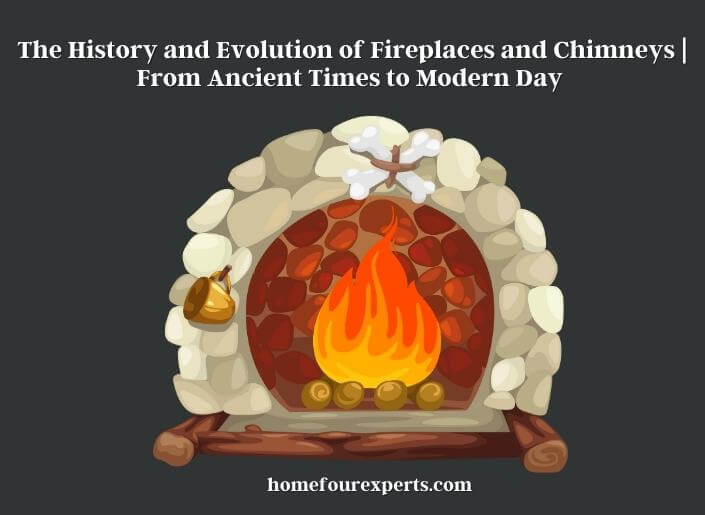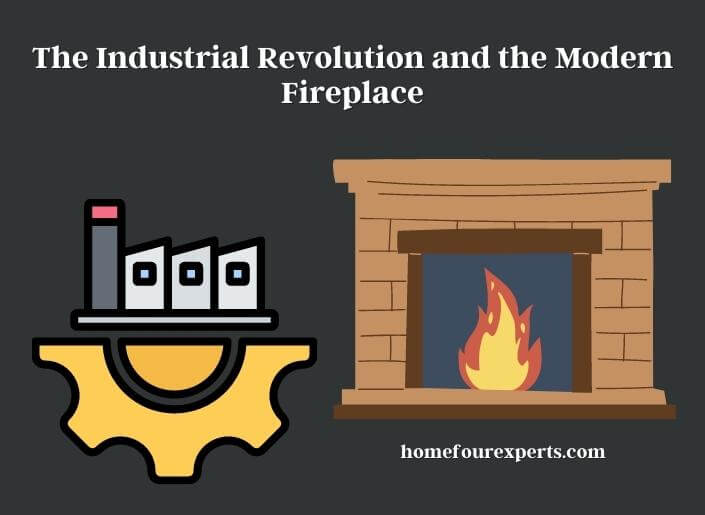The fireplace and chimney have been integral features of homes for centuries, providing warmth, comfort, and ambiance. However, their evolution has been a journey that spans millennia. The history of fireplaces and chimneys is a testament to human ingenuity, as humans have continually developed new technologies and designs to improve their functionality and efficiency.

From the earliest forms of fireplaces discovered in ancient caves to the latest energy-efficient designs, fireplaces and chimneys have come a long way.
We’ll delve into the earliest forms of fireplaces and chimneys, the changes brought about by the Industrial Revolution, and the latest innovations in the fireplace and chimney design.
The Early History of Fireplaces and Chimneys
The earliest known fireplaces were found in caves in Europe and Africa, dating back more than 1 million years. These early fireplaces were simply pits in the ground where fires were built for warmth and cooking. Humans began to develop more advanced forms of fireplaces, including raised hearths made of stone or clay.
The ancient Greeks and Romans were among the first to use chimneys to vent smoke and heat from their homes. The Romans even developed a sophisticated system of flues and chimneys to heat their public baths and homes.
Medieval European homes had fireplaces that were built into the walls, often with elaborate hoods and chimneys that rose up through the roof. These fireplaces were primarily used for cooking, and the smoke and heat were often directed to the upper floors of the home to provide warmth.
The Industrial Revolution and the Modern Fireplace
The Industrial Revolution brought significant changes to fireplace design and technology. Cast iron became a popular material for fireplaces and stoves, and new innovations in chimney design allowed for more efficient heating and ventilation. The introduction of coal as a fuel source also had a significant impact on fireplace design, as coal-burning stoves and fireplaces became more common in the 19th century.

In the early 20th century, gas and electric fireplaces were introduced, providing a more convenient and cleaner alternative to traditional wood-burning fireplaces. These new technologies also led to innovations in fireplace design, with sleek, modern fireplaces becoming popular in mid-century homes.
Recent Innovations in Fireplace and Chimney Design
In recent years, the focus on energy efficiency and sustainability has driven new innovations in the fireplace and chimney design. As concerns about climate change and energy consumption continue to grow, manufacturers and designers are increasingly looking for ways to make fireplaces and chimneys more environmentally friendly and efficient.
One of the most significant recent innovations in the fireplace and chimney design is the development of high-efficiency wood-burning stoves and fireplaces. These stoves and fireplaces use advanced combustion technologies, such as catalytic converters and secondary burners, to reduce emissions and increase heat output. High-efficiency wood-burning stoves and fireplaces can burn wood more cleanly and efficiently than traditional fireplaces, resulting in lower fuel costs and reduced environmental impact.
Another sustainable alternative to traditional wood-burning fireplaces is pellet stoves. These stoves burn compressed wood pellets, which are made from sawdust and other wood waste products. Pellet stoves are an excellent option for those looking for a more sustainable and eco-friendly heating solution. They are also more efficient than traditional wood-burning fireplaces, as they burn more cleanly and produce less ash and smoke.
Advances in chimney design have also led to more efficient and effective ventilation systems. Direct-vent gas fireplaces, for example, use a sealed combustion chamber and venting system to reduce heat loss and improve indoor air quality. This type of fireplace eliminates the need for a traditional chimney and can be installed in a variety of locations, including outside walls and roofs.

In addition to their energy efficiency and environmental benefits, modern fireplaces and chimneys also offer a range of design options. From sleek and modern to traditional and ornate, there is a fireplace and chimney design to suit every taste and style. Modern fireplaces can be made from a variety of materials, including stone, brick, and glass, and can be customized to match the decor and aesthetics of any home.
Details About Middle Ages and Renaissance
The Middle Ages and Renaissance were crucial periods in the history of fireplaces and chimneys. During the Middle Ages, fireplaces began to be installed in more affluent homes, replacing the earlier hearths and providing better heating and cooking facilities. These early fireplaces were often made from stone and had a simple design, with a large opening and a chimney to vent smoke.
During the Renaissance, fireplace design became more ornate and decorative, reflecting the growing wealth and status of the upper classes. Fireplaces became the centerpiece of the home, with intricate carvings and designs, and were often made from marble or other expensive materials. Chimneys were also improved during this time, with the development of chimneys that rose through the center of the house, allowing smoke to be vented more efficiently.
Their decorative and functional value, fireplaces, and chimneys also played an important role in the social and cultural life of the Middle Ages and Renaissance. They were the center of family life, with meals cooked over the open flames and family members gathered around the hearth for warmth and conversation.
The development of fireplaces and chimneys during the Middle Ages and Renaissance also had significant economic and political implications. The increased use of fireplaces and chimneys in homes led to a growing demand for wood, which fueled the development of the timber industry and the establishment of new trade routes for wood and other building materials. The construction of large, ornate fireplaces and chimneys also became a status symbol, with wealthy families competing to build the most impressive and luxurious designs.
The Middle Ages and Renaissance were transformative periods in the history of fireplaces and chimneys. These essential home features evolved from simple hearths to ornate, decorative pieces that played an important role in the social, cultural, and economic life of the time. Today, we can still see the legacy of these periods in the many beautiful and functional fireplaces and chimneys that grace our homes.
18th and 19th centuries
The 18th and 19th centuries saw significant changes in the design and use of fireplaces and chimneys. As homes became larger and more complex, fireplaces became more than just a source of heat and cooking. They became a statement of style and sophistication, with intricate designs and elaborate decorations.
During the 18th century, fireplaces were often designed to be the focal point of a room. Large and ornate, they were typically made from stone, marble, or other high-end materials. Decorative motifs and carvings were common, as were intricate mantelpieces that displayed family portraits, fine china, and other prized possessions.
The 19th century saw the introduction of cast iron fireplaces, which were more affordable and easier to manufacture than their stone and marble counterparts. Cast iron fireplaces were often designed in the Gothic or Rococo styles, with elaborate patterns and motifs that reflected the popular tastes of the time. The introduction of cast iron also led to a wider range of fireplace designs, as manufacturers could now produce more intricate and detailed designs at a lower cost.
The development of the Rumford fireplace by Benjamin Thompson in the late 18th century revolutionized the way fireplaces were designed. Rumford fireplaces were shallower and more efficient than traditional fireplaces, with a narrower throat and angled sides that helped to reflect heat back into the room. These fireplaces were also more effective at drawing smoke out of the room, thanks to their improved chimney design.
The 19th century also saw the introduction of coal-burning fireplaces, which were more efficient than wood-burning fireplaces and produced less smoke and ash. This innovation led to a significant shift in the way homes were heated, as coal replaced wood as the primary fuel source for heating.
These essential home features became more than just functional heating and cooking devices; they became works of art and symbols of wealth and sophistication. The innovations of this time, such as the introduction of cast iron and the development of more efficient fireplace technology, paved the way for the modern fireplaces and chimneys that we see today.
Why Do They Remain Important Today?
Despite advances in heating technology, fireplaces and chimneys remain important today for several reasons:
Heating: Fireplaces provide a source of heat that can be used to warm a room or even an entire house. They are especially useful during power outages or in areas where electricity or gas may not be readily available.
Ambiance: Fireplaces create a cozy and inviting atmosphere that many people enjoy. The flickering flames and gentle crackling sounds can help to create a relaxing and peaceful environment.
Aesthetics: Fireplaces can be a beautiful addition to any home, adding a touch of elegance and sophistication to the decor. From rustic stone fireplaces to sleek modern designs, there are a variety of styles to choose from that can complement any interior design scheme.
Energy efficiency: Many modern fireplaces are designed to be energy efficient, using less fuel and producing fewer emissions than older models. This can help to reduce heating costs and minimize the environmental impact of heating a home.
Resale value: Homes with fireplaces often have a higher resale value than those without. A well-designed and well-maintained fireplace can be a major selling point for potential buyers and can help to increase the overall value of a home.
Fireplaces and chimneys remain an important part of modern homes for both practical and aesthetic reasons. While they may no longer be the primary source of heat in most homes, they continue to provide warmth, ambiance, and style that can enhance any living space.
Summary
The history and evolution of fireplaces and chimneys is a testament to our enduring fascination with fire and our ability to harness its power for both practical and aesthetic purposes. From the ancient hypocausts of Rome to the modern gas fireplaces of today, fireplaces and chimneys have played a crucial role in shaping the way we live and interact with our environments.
While fireplaces and chimneys may have evolved significantly over the years, they remain an important part of many homes today. Whether for heating, ambiance, aesthetics, energy efficiency, or resale value, fireplaces continue to provide a range of benefits that make them a valuable addition to any living space.
As we look to the future, it’s likely that fireplaces and chimneys will continue to evolve and adapt to meet the changing needs and desires of homeowners. However, one thing is certain: the timeless allure of fire will always be with us, inspiring us to create new and innovative ways to harness its power and beauty.
About This Writer

Hi, I am Eric Devin and I am a professional interior architect. Since childhood, I've always enjoyed DIY projects! And, I have loved to solve simple household problems using essential tools and equipment. I have also acquired a lot of information about basic household tools settings by working with contractors.